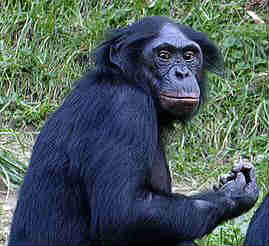Ape to Human Evolution
A history of the idea
EUGENE M. MCCARTHY, PHD GENETICS
|
|
The idea of ape to human evolution found its original spark in the 18th century. The voyages of discovery had revealed the existence of chimpanzees, orangutans, and gibbons (the gorilla remained unknown to European science until the 1840s, and the bonobo, until the 1920s), and anatomical comparisons soon suggested these animals were somehow connected with human beings. As the Comte de Buffon put it, an ape "is only an animal, but a very singular animal, which a man cannot view without returning to himself" (Histoire naturelle, vol. 14, p. 4, 1766).
The fact that humans and apes share many anatomical traits did not escape Linnaeus, who is often cited as the first classifier to assign the two to a single taxonomic order. In the first edition of the Systema Naturae (1735), he placed both in Order Anthropomorpha, which he later renamed as Order Primates (10th ed., 1758). Although the name Anthropomorpha means "having human form," he made no explicit statements about ape to human evolution. Nevertheless, his categorization of humans with the apes encouraged later naturalists to think of the two as related by descent. As early as 1794, the philosophe Delisle de Sales (Histoire philosophique du monde primitif) commented that the apes "seem to form an intermediate line between animals and human beings."
But the assignment of apes and humans to the same category was controversial and drew objections from conservatives. For the most part, taxonomic classifications prepared by Linnaeus' successors kept Homo separate from the apes. By 1800 this was the norm. But even those classifiers who failed to follow Linnaeus' cue and placed humans and non-human primates in separate orders (Order Bimanes and Order Quadrumanes, respectively) generally recognized an affinity between apes and human beings. For example, the French naturalist Constant Duméril in his Zoologie analytique (1806, p. 8) speaks of the genus Pithecus as containing "the species of apes that most closely approach man." Similarly, in his systematic arrangement of the animal kingdom Cuvier follows the separate arrangement, but describes Quadrumanes as "the order closest to man" (Règne Animale, 1817, p. 79).
At the other end of the spectrum, some — far from separating humans and apes — suggested that apes were not intrinsically different from human beings. In particular, James Burnett, Lord Monboddo argued at length (Of the Origin and Progress of Language, 1774, vol. II, book 2) for the idea that apes were merely wild variants of human beings.
Jean-Baptiste Lamarck (1744-1829), however — a former soldier who had been decorated for bravery — seems to have been the first naturalist with the nerve to propose publicly and explicitly that human beings had evolved from apes (Philosophie zoologique, 1809): "Certainly, if some race of apes, especially the most perfect among them, lost, by necessity of
After Lamarck, naturalists took the idea of ape to human evolution more and more for granted. For example, in his Vestiges of the Natural History of Creation (1844), Robert Chambers stated that the primates are distinguished "by greater relative magnitude of brain, by agility, and by
Nevertheless, in the Origin of Species (1859), Darwin makes no mention of ape to human evolution. His only allusion to the topic was a comment, in regard to his theory, that "Light will be shed on the origin of man, and his history."
Darwin's friend and advocate Thomas Henry Huxley (1825-1895) was far bolder on this topic than was Darwin himself. In his 1863 book Evidence as to Man's Place in Nature, Huxley summarized the many anatomical traits shared by humans and apes and asserted that such evidence supported the hypothesis that humans and apes had evolved from a recent common ancestor. It was the first book devoted expressly to the topic of human evolution.
Darwin published nothing on the topic until 1871, when his own book The Descent of Man appeared, twelve years after publication of the Origin. The Descent of Man is often supposed, erroneously, to have appeared at a time when the evolution of apes and humans from a common ancestor had not as yet been discussed. In fact, however, it was merely Darwin's attempt to weigh in on a topic that had long been broached.
In the years since Darwin and Huxley, a wide variety of fossil forms ("hominids") have, of course, come to light, which are now widely taken as evidence that ape to human evolution actually did occur. But is it possible that we are not from the apes alone? An alternative theory of human origins, explained elsewhere on this website, proposes that we may be the descendants of a hybrid cross.
